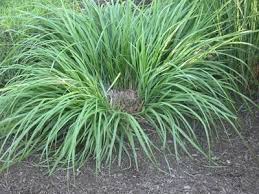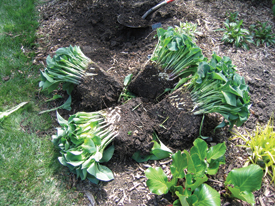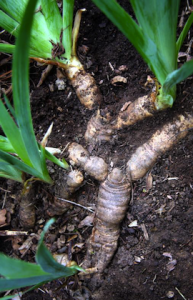Dividing Perennials
By Pat Dickey, Fairfax Master Gardener
Fall is the time when flowering perennials begin to show their wear from all the work they did to produce flowers during the spring and summer in your garden. Now is a good time to divide and rejuvenate them. You may want to produce more plants to share with your friends or just have more for other areas of your garden. With the exception of a few, most perennials can be divided every three to five years. Some do not want to be divided, and others can wait eight to ten years.

dead center indicates need of dividing
How can you tell whether a perennial should be divided? Its flowers are smaller than usual. There is a dead space or hole in the center of the plant. The overall growth of the perennial has been less vigorous, or it grew out of the boundary of its intended area. Also, the foliage at the bottom of the plant has become sparse and leggy.
Perennials that bloomed in the spring and summer should be divided in the fall. Those that now have flowers should wait until the spring before you divide them. You can also wait and divide some spring blooming perennials in April or May, when they have finished flowering. Just remember to divide the perennials when they don’t have flowers, so that all the plant’s energy will go to support root and leaf growth. A perennial divided in the fall needs six weeks to become established in its new permanent location before the ground freezes.
There are a few steps that you must take before dividing perennials. Check the area and soak the ground, if needed, one to three days prior to dividing. Plan to work on a cool or an overcast day. Prepare ahead the holes and/or pots for the newly divided plants. You will want to transfer the divided plants quickly so that their roots do not dry out. Gather your tools; you will need a spade or shovel, digging forks, or a sharp garden knife, depending on the type of roots your perennials have.

hosta divided
Cut back the stems and foliage of the plant to be divided to 6 inches from the ground. This will better direct water to the roots rather than losing water through the foliage. Dig into the ground with a spade or shovel around the perimeter of the plant at the drip line. Then loosen the roots and isolate the portion you want to divide. Remove the clump and, while keeping it intact, shake off any excess soil. Examine the plant’s roots for places to make natural cuts.
Perennials have several types of roots, and each one is divided differently. Many have fibrous roots that are spreading or clumping. Spreading root systems grow outward from the original crown of the plant. Each new shoot grows separately from the crown and has a partially separate root system. To divide spreading roots, gently pull apart the new shoots with their roots or use two forks or shovels to pry apart any tougher, fibrous roots. Clumping roots are fleshy and thick, growing downward more than outward. Their new shoots come from buds attached to the original crown, and their root systems are closely intertwined. Divide them by cutting the crown into pieces with a spade, with each piece having a few buds with attached roots.

iris rhizomes needing dividing
Rhizomes are thick, fleshy stems that spread outward underground with roots and small shoots growing off of them. They can be divided from the original plant with a sharp knife into individual new plants that look like ‘fans’, with a few buds on each one. Some perennials also have taproots, making them more difficult to divide. Divide these with a sharp knife, leaving one good ‘eye’, some side roots and part of the taproot. Others have small plants or offsets that grow alongside the mother plant and are easy to separate. Separate them by hand or with a small garden knife and take away three new parts along with roots. Some bulbs have tubers, another type of root, that can be separated with a knife.
When dividing all the perennials, make sure to discard dead or diseased parts. Water well for the next couple of weeks and add two inches of mulch. Do not add fertilizer until next year. Your perennials will love you for all of this attention.
References
When to Divide Perennials, Iowa State University Extension
Dividing Perennials, Cornell Cooperative Extension of Chemung County
Dividing Perennials, Penn State Extension
. . . updated 2022